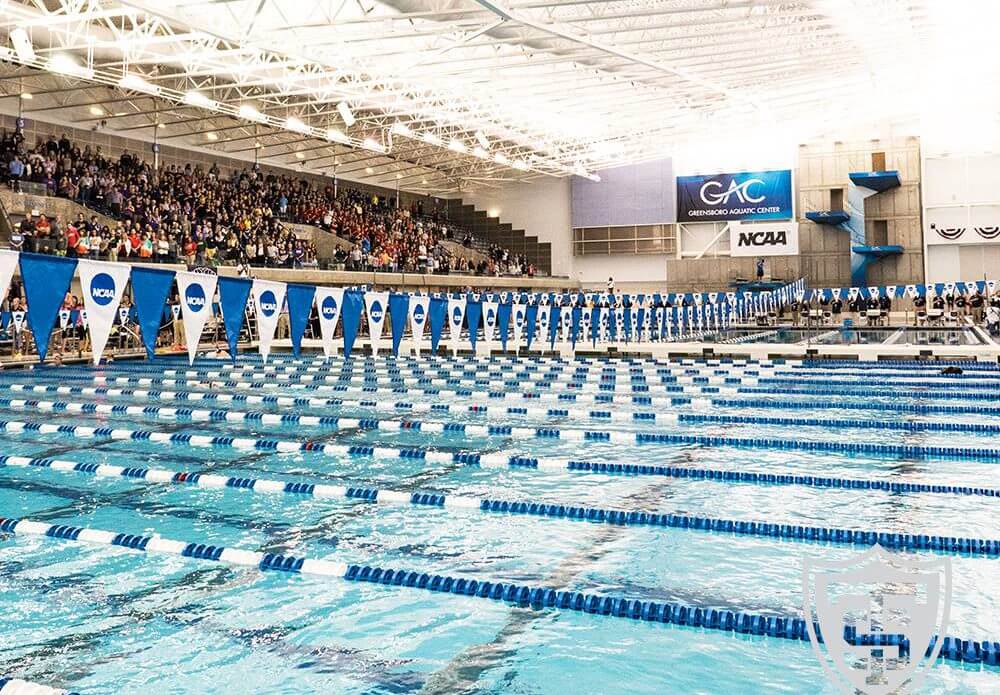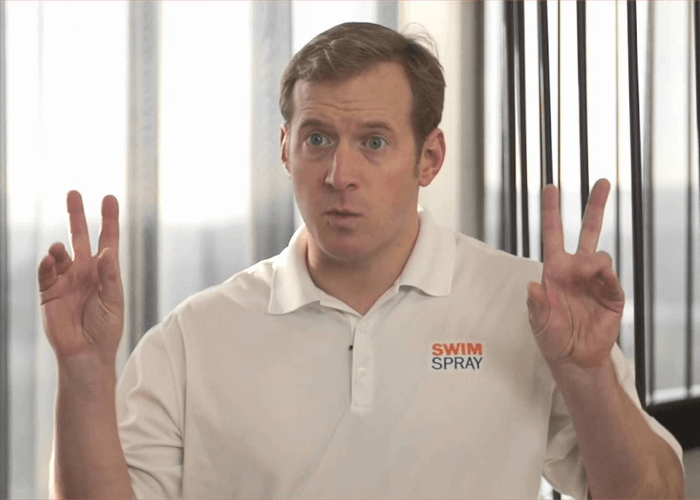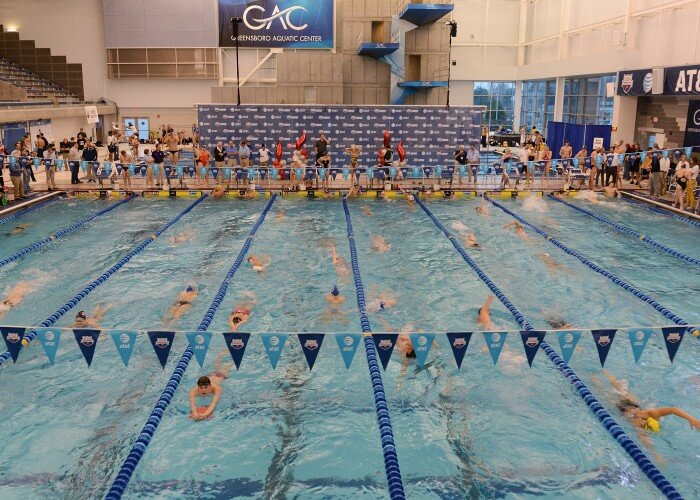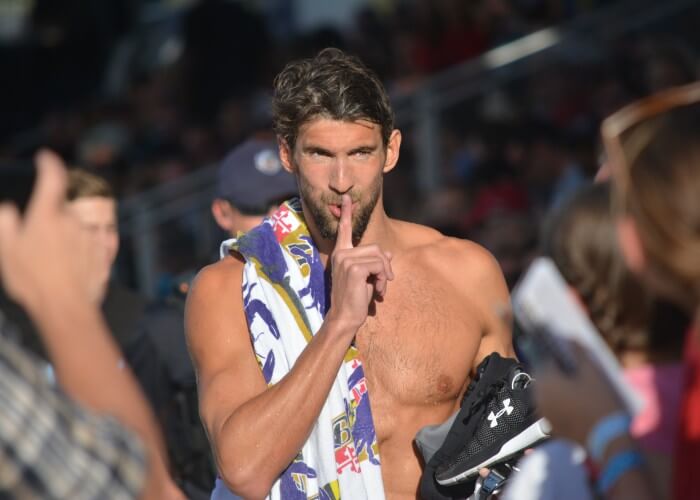Indoor Pool Air Quality: Addressing One of the Nation’s Most Underrated Issues

By Caitlin Daday, Swimming World College Intern
At the 2013 USA Swimming Winter Junior National Championships in Greensboro, North Carolina, 2016 Olympian Caeleb Dressel was hospitalized in the middle of the meet. The reason? The air quality.
The Greensboro Aquatic Center is just one of myriad pools across the nation that repeatedly leaves swimmers struggling to catch their breath. Violent coughing, burning eyes, and dry and blotchy skin afflict almost any swimmer who has ever swum in an indoor pool.
Yet although poor air quality in indoor pools affects nearly all swimmers at some point in their careers, little effort has been made to seriously address the problem. In fact not a single study has been done to see what effects prolonged exposure to bad air has on swimmers even after they hang up their goggles.
Aimee Schmitt is a former member of the USA Swimming National Team and now serves as vice president of sales for Swim Spray, a product developed to help eliminate chlorine from swimmer’s bodies. Today, Schmitt is highly allergic to chlorine. She and her husband, also a former swimmer, cannot even be in an indoor pool for more than 15 minutes to watch their daughter swim before the chlorinated air begins to affect them.
“We’ve moved forward with improved suits, training, blocks, caps, goggles, you name it,” Schmitt says. “But our approach to the water hasn’t changed.”
Air quality issues in indoor pools are not being properly addressed. In a sport like swimming, Schmitt says, having healthy air to breath is incredibly important.
Schmitt says that awareness is the first step to solving the problem. At this point there are still many unanswered questions about the size and scope of the issue. There are people searching for a solution, but at this point they still do not know all the answers.
The next step is understanding the source of the problem.
Fortunately for swimmers the issue is not pure chlorine, Andrew Chadeayne, the creator of Swim Spray, says. Chlorine by itself is essentially a chemical weapon, so chlorine alone would be deadly. What swimmers actually breathe in is a collection of molecules.
“The number one offender is pee in the pool because of a chemical called urea,” Chadeayne says.
Urea has two nitrogen molecules in it, which react with chlorine to create chloramines, he says. Other oils on our bodies help to form chloramines as well. Chloramines are the culprit. When they are agitated, such as when swimmers are in the water, they begin to cause coughing and irritation.
According to the Centers for Disease Control, chloramines are most concentrated just above the surface of the water. The gas they release is heavier than air, which means that the bulk of the chloramines settle right where they can cause the most problems for swimmers.
Facilities managers contribute to the problem by not being wary of the actual amount of chlorine in the pool, Chadeayne says. Free chlorine molecules react with each other and become combined. Combined chlorine is what throws managers off.
When a facilities manager measures the chlorine in the pool, they are only looking at free chlorine levels, Chadeayne says. If the chlorine molecules are combined, the free chlorine reading looks low. They then add more chlorine, only making the issue worse. Now there is too much chlorine in the pool, and even more chloramines are able to form.
Many coaches or facilities managers attempt to improve the situation for their athletes by turning on fans or opening up doors. To the dismay of many, these very short term solutions do little.
“It’s like in your dorm in the corner you have a can of rotten eggs and put a fan in but keep the eggs there,” Chadeayne says. “The smell keeps coming out just as fast as the fan is going.”
Open doors are just as useless. In fact doors can even cause more harm if they are letting cold air in, Chadeayne says. Cold air entering the building will create a cloud or vapor above the pool rather than getting the chloramines out.
Mick Nelson, facilities director for USA Swimming, says the only cure is to get swimmers in the showers and to get them to stop peeing in the pool. When meets get bad, a lot of the problems can be tied back to how bathers have treated the pool in the last week.
“One person not taking a shower can affect the pool for nine days,” Nelson says. “The people that complain are the ones causing the problems.”
At this point fixing the problem is dependent upon swimmers and coaches being educated enough to enforce showering before swimming and getting out to use the bathroom, Nelson says. By rinsing off all the sweat and oils on their bodies and not using the pool as their personal toilet, swimmers can help improve their own situation by preventing the creation of chloramines. The cure, however, is difficult to enforce.
At big meets such as the Junior Nationals in Greensboro, it is getting harder and harder to encourage swimmers not to pee in the pool. Tech suits are too hard to get on and off, and when you have to go, well, you have to go. Telling an athlete not to pee in the pool is almost hopeless.
There is also the fact that all the big names are doing it. Even Michael Phelps admits that he pees in the pool. How can you teach young kids not to do something when the greatest of all time admits to doing it?
The only way to mitigate the effects is to get an ultraviolet filter system, Nelson says. In UV systems, a steel tube with UV in it is placed in the pool’s filter. When the water goes through, it gets zapped by UV. The UV then destroys any chloramines and viruses that may be in the water.
UV systems are great for daily use, Nelson says. But for big meets, they are not quick enough. The whole process takes six hours, so when there are hundreds of swimmers in the pool, the air quality begins to deteriorate rapidly.
There are other “solutions” out there, but they too are largely ineffective. “It’s like putting a filter on a cigarette and saying it’s healthier,” Nelson says. There is no way a system can bring in enough fresh air.
The CDC recommends setting up a system that not only brings in fresh air but also pumps out enough of the bad air. If fresh air is only being brought in, the contaminated air will build up. Likewise, facilities also need to continue to bring in fresh air even when it is cold, despite the increased cost. Otherwise the negative health effects will increase.
While there are ways to handle air quality issues, the problems still persist. Even the best facilities in the nation can bring about trouble. If the problem is so widespread, what is being done about it?
At this point, not really anything.
Schmitt says the air quality issues are among the more taboo topics of the swimming world—no one has really had a chance to talk about it yet. There are clearly problems, but they are largely under recognized.
Still today, in 2016, no one really knows how bad constant exposure to contaminated pool air is for swimmers, Chadeayne says. The short term effects are obvious. It is bad when athletes are constantly unable to breathe. It is bad when athletes cannot sleep because they are up coughing so much. It is bad when violent coughing leads to vomiting.
If these are only the short term effects, what about down the road, later in life? That still remains to be seen, Chadeayne says. There is the potential relation to asthma and other respiratory problems, but as there have been no studies, these links cannot be definitively proved.
As of now, there are two pending law suits involving the connection between respiratory problems and bad air quality, Nelson says. The way things are going, these are likely only the beginning.
The air quality problem is not going away. Until it is properly addressed, swimmers will continue to train and compete in pools that literally take away their ability to breathe, with little knowledge of what damage will be done to their future health.
All commentaries are the opinion of the author and do not necessarily reflect the views of Swimming World Magazine nor its staff.






Hence why the pool is given the acronym GAC!
I think the person who invents a pull open flap for peeing in tech suits will be laughing all the way to the bank. If it’s possible to use a toilet easily, I think a swimmer will. That’s why I like regular non-kneeskin suits. You can pull the crotch aside easily to go pee.
Most female athletes with tech suits on just go to the shower in the locker room and pee through their suits standing up. Easiest solution..
Chlorine cough is brutal!
Hi Karin, if we can assist in any way don’t hesitate to reach out!
The University of Maryland almost killed us all this past weekend at the NCAP Invite because the air was so bad. ? I needed three days to rid my cough!
It was horrible. Bryans skin was burned from the chlorine as well. No bueno
Re:chlorine burn on skin–SwimSpray is a patented chlorine neutralizer for skin, hair and suits.
Not half as bad as the Fairland Aquatic Center — I watch that meet from my car.. h
The NCAP invite got bad when swimmers continued to place towels and bags and their bottoms on the vents. Constant nagging helped at the time then 20 minutes later they were blocked again ?
I was there and I agree. After each of my races at NCAP I coughed so hard I threw up.
Hi Jessica and Charlie, we are sorry to hear about the IAQ problems at the meet. If we can assist in any way don’t hesitate to reach out!
Ally-Karen Miller Megan Emerson
Abi Rutledge we talked about this All the time!
Hi Rachel and Abi, if we can assist in any way please let us know!
Kaitlyn!
Christine Scollay!!
Cheryl Wheatley Kerrie Osborne
So did u share with work?
Randi Savage
developed lung/breathing problems during several seasons… the wee offenders were not bashful to admit they peed in the pool.
One season they had to drain/clean the pool it was so bad.
Erin, we are sorry to hear about your respiratory problems. If we can assist in any way don’t hesitate to reach out!
In Clearwater this past weekend and chlorine was so bad faces were burnt and myself as spectator affected my lungs so bad I now have pneumonia!
Debbie, we are sorry to hear about your respiratory problems. If we can assist in any way don’t hesitate to reach out!
Vidur Sharma…… throwback Friday… weren’t you super involved with something like this?
Yikes
Jeff – please share with Beth!
They are getting ready to shut down our indoor pool here in Vegas after years of being cited for poor air quality their finally doing something about it. My children swim and so do I as well. It’s hard to breath and I cough a lot and I break out when I’m indoors. I grew up in CA and swam outdoors, it was cold but I never had the problems I do like I have after swimming indoors
Jennette, we are sorry to hear about the pool closing – please let us know if we can assist!
Paddock Evacuator I just want somewhere close to swim that isn’t a gym, their are none so I’m now looking into joining a gym to swim till it’s fixed, it’ll be about 2 1/2 months
If the kids stopped peeing in the pool, the air would be much better. It’s not the chlorine, but what’s it’s reacting with.
Sarah Noll
Brian Lowry
Eric Zhu
Lmao @brandeis
Eric Zhu @babson
True the two bad pools
Morgan
Robin Mays Wrabley LITERALLY ME
You’re famous
Prudence Roberts Milligan
I wish we could blame urine for SEVA. Mama’s not allergic to urea, however I am to mold. But good read.
Casey Wrabley
Marjorie Cote McCord
Interesting
Huge problem at the big meets. Burning eyes, rashes, coughing, trouble breathing and nasea for some.
Hi Nimet, please let us know if we can assist in any way!
Water quality and air quality go hand-in-hand! Laws need to be changed to enforce proper water quality. Current test requirements/limits do not even measure the harmful bi-products in pool water and “janitors” are not qualified to handle pool water quality maintenance.
We brought in a CPO trainer to certify our staff and even that seems like it may not be enough to run a pool at a very high level. Crazy to think some pool operators don’t even have that training…
CPO training is a great first “baby-step”; It’s just a piece of paper. The DEQ needs to change the laws and States and Counties NEED to comply. It’s a complex environment in which unfortunately nothing will change until the laws change.
This is a great article that exposes a significant health issue for anyone in a pool environment. My personal belief and experience is that a UV system can eliminate most of these problems along with the idea that you swimming in your own urine is repulsive.
Hi Bob, chlorine does a really good job neutralizing urine and other organics while UV can work well as a secondary disinfectant – but both lead to increased offgassing of disinfectant byproducts. We always appreciate feedback for how we can better improve IAQ in natatoriums if you have a few minutes to talk or shoot us an email.
Someone needs to share this with the Kewanee Y
Hello Mary Jane, let us know if we can assist
Don’t forget the plight of the poor lifeguards and swim instructors, who may spend 30 to 40 hours per week breathing that air. I can remember my son coming home from the doctor with a diagnosis of “lifeguard lung.”
I get that myself between lifeguarding and teaching swim lessons. Last year I would spend 6-7 hours per day in the pool area. Worse is our Certified Pool Operator (CPO) does not maintain it properly and our combined chlorine (chloramines) is usually 4 to 5 times the recommended maximum level of 0.5 ppm. Worse is I have my CPO certification, I know what is wrong and how to fix it but I cannot.
Quick way to know if the pool is healthy is to smell the air and water. If it smells like chlorine you have too many chloramines. If you open a bottle of bleach, which is is the same chemical used in pools, and smell it you don’t really smell the chlorine. Use a little to clean something and the smell gets really strong.
Marie, we are sorry to hear about your son’s respiratory problems. If we can assist in any way don’t hesitate to reach out.
Thank you. This was some years ago. He moved to a job in a larger parks and recreation system with better standards, and the problem pool in our suburb was later torn down and replaced with an excellent recreation complex with amazing modern aquatic facilities. There should be air quality standards for pool employees.
KC Blazers east used to train in a pool that was meant to be opened in the summer, but they made it year round without installing a proper ventilation system. Everybody used to cough and cough sometimes they’d cancel practice. It took them years to fix the problem. Chlorine fog is definitely hard on the lungs. Pools need to be tested regularly for air quality especially bubble dome pools, those are usually some of the worst.
Hi Zach, if we can assist with the air quality please let us know. There is a huge challenge in measuring airborne chloramine level as there is no quick, reliable testing equipment. Once that is developed, it would certainly ruffle a lot of feathers.
First off I’m a lifelong competitive swimmer and coach that has had the pleasure and the not-so pleasure of visiting swimming pools/so-called aquatic venues all over this country and outside the USA. You obviously haven’t been back to the Greensboro Aquatic Center. They installed an in-gutter Evacuator in the dive well (where warm up/cool down happens and most swimmers choose to pee) The GAC is UV and happens to have one of the BEST pool technicians (Richard E Tuttle) and managers (Susan Newell Braman) in the COUNTRY!!! BELIEVE ME, they know POOL CHEMISTRY!! Maybe you should consider doing your “fact checks” and READ the AWESOME reviews the GREENSBORO AQUATIC CENTER has received in the last two years on air quality. Better yet, you SHOULD come back for a visit.
Agreed!! Have an NC swimmer with asthma and it’s one of the best big pools in NC as far as good air quality and being able to compete without respiratory issues.
This system wasn’t in place at first Winter Jrs. In fact, there was a Masters meet there prior to Jrs and the complaints from that meet were huge. So, before you get testy, please know that this was written about the Jrs meet Caleb Dressel swam at.
Betsy Harrison not testy just stating CURRENT facts. I swam at Masters Nationals. Stories in the media like this, that have outrageous headlines and out of date information HURT facilities which can indirectly hurt Swimming. As a swimmer, I would want to compete in the best facilities~ not only FASTEST but also the HEALTHIEST. I’m thinking this story should had first been noted with ****All commentaries are the opinion of the author and do not necessarily reflect the views of Swimming World Magazine nor its staff.**** As readers, I would hope everyone would remain educated and not naive ~We should not be FOOLED into reading headlines that are actually for articles that are used as fillers~or even to sell products.
Hey Tracy just chill out for a second. The facts were stated correctly in the article. Think about the swimmers before you defend a swimming facility. There need to be standards set in place so our swimmers don’t come home from swim meets with bronchitis and pneumonia.
You are defending a facility in which gives you a pay check every week? No bias there?
Tracy, we appreciate your feedback and completely agree – the biggest testimonial we can provide is “Visit GAC.” I was there for Masters Nationals this year and the air was fantastic
Paddock Evacuator thank you?
Triona Morgan
Cassandra Padula Burke
Thanks Helen
Nick Russell
lisa Lisa Lawrence..get suzukie roxy onto his..
Heather Starner Dougherty
Didn’t we just talk about this?
It’s really difficult to get pool officials at meets to care about air quality. They just shrug heir shoulders.
Hi Nancy, unfortunately some facilities face tough budgetary choices and others may not be fully informed on the health risks. Please reach out to us if we can assist in any way.
Paddock Evacuator I will, thanks!
Jeremy Wolfmeyer
Kate Kaduboski
I ended up in the ER with a 2 day hospital stay all brought on by the air quality of the pool we were at!
Susan, we are so sorry to hear about your respiratory episode. Please let us know if we can assist!!
Anne Warren
Thomas Fortunato
This was very informative. I know one swimmer that has had a very bad time at JR Nats EVERY time it is held at an indoor facility. This past Jrs she had to have a breathing treatment from the onsite Dr.
Was she at Texas or Ohio Jrs?
Hi Betsy, after the event described in the article, GAC worked with us to address the problem. Currently, feedback regarding their air quality is excellent. We’d appreciate any feedback you may be able to provide as to how we can better help indoor facilities
Paddock Evacuator if I had the answer to that I’d be rich! LOL. someone will figure it out someday.
Julie Springer Margolis-right!???
Damien Autissier
#makebgcgreatagain
Jack Sinclair
so fucking hip
Sydney Ann Tobias
Our son developed breathing issues while doing Winter swim at Providence Rec Center in Virginia. His coach accused him of being a slacker instead or recognizing the issue with chlorine. I am glad that this is finally being addressed 20 years after our concerns !
Jean, we are sorry to hear about your son’s respiratory problems. If we can assist in any way don’t hesitate to reach out.
Go Shelly go!
You know it!
hah. Yeah. That time I couldn’t open my eyes at Zones and a week later GCIT was shut down